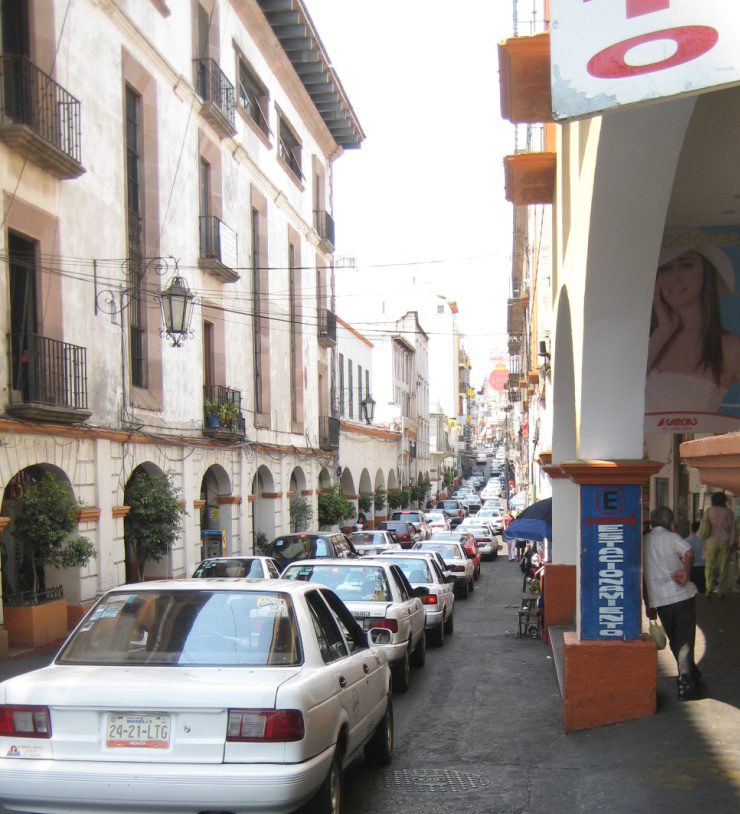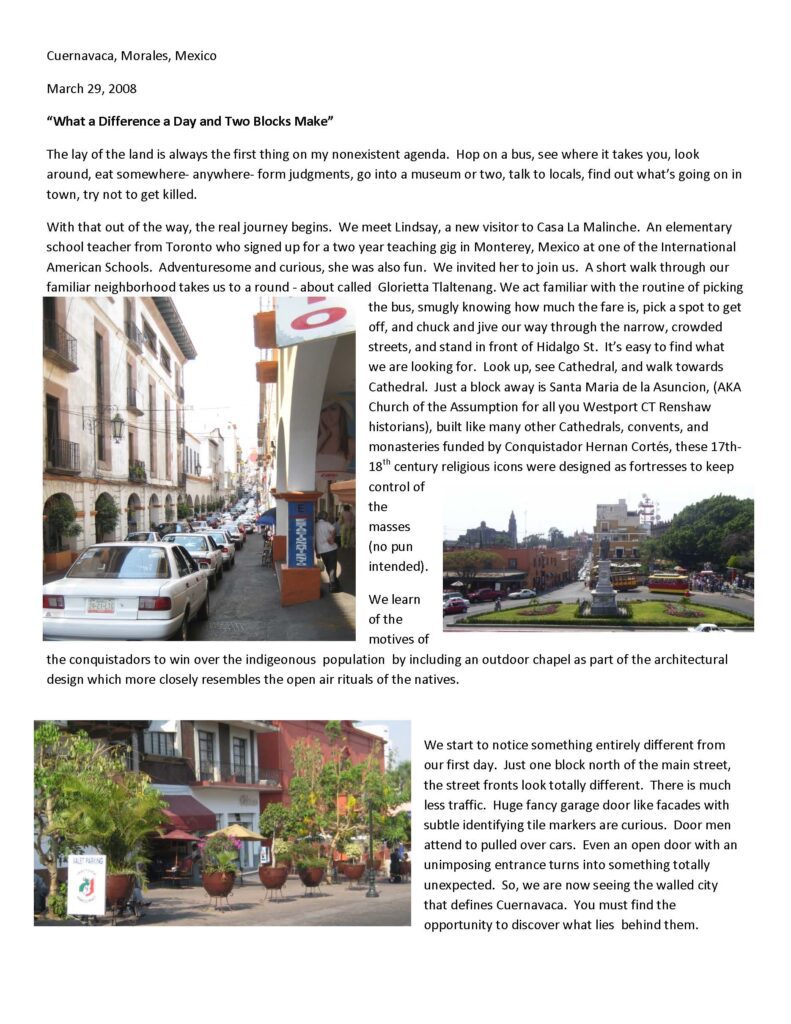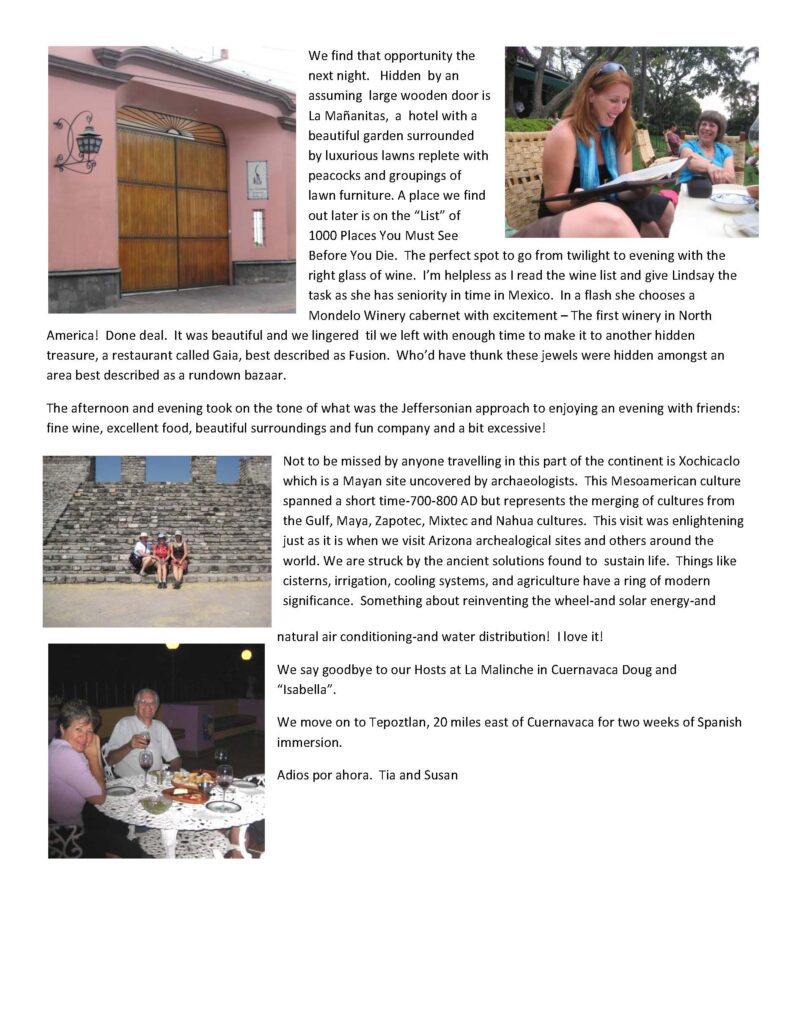
March 29, 2008
“What a Difference a Day and Two Blocks Make”
The lay of the land is always the first thing on my nonexistent agenda. Hop on a bus, see where it takes you, look around, eat somewhere‐ anywhere‐ form judgments, go into a museum or two, talk to locals, find out what’s going on in town, try not to get killed.
With that out of the way, the real journey begins. We meet Lindsay, a new visitor to Casa La Malinche. An elementary school teacher from Toronto who signed up for a two year teaching gig in Monterey, Mexico at one of the International American Schools. Adventuresome and curious, she was also fun. We invited her to join us. A short walk through our familiar neighborhood takes us to a round ‐ about called Glorietta Tlaltenang. We act familiar with the routine of picking the bus, smugly knowing how much the fare is, pick a spot to get off, and chuck and jive our way through the narrow, crowded streets, and stand in front of Hidalgo St. It’s easy to find what
we are looking for. Look up, see Cathedral, and walk towards Cathedral. Just a block away is Santa Maria de la Asuncion, (AKA
Church of the Assumption for all you Westport CT Renshaw historians), built like many other Cathedrals, convents, and
monasteries funded by Conquistador Hernan Cortés, these 17th‐18th century religious icons were designed as fortresses to keep
control of the masses (no pun intended).
We learn of the motives of the conquistadors to win over the indigenous population by including an outdoor chapel as part of the architectural design which more closely resembles the open air rituals of the natives. We start to notice something entirely different from
our first day. Just one block north of the main street, the street fronts look totally different. There is much less traffic. Huge fancy garage door like facades with subtle identifying tile markers are curious. Door men attend to pulled over cars. Even an open door with an
unimposing entrance turns into something totally unexpected. So, we are now seeing the walled city that defines Cuernavaca. You must find the opportunity to discover what lies behind them.
We find that opportunity the next night. Hidden by an assuming large wooden door is La Mananita, a hotel with a beautiful garden surrounded by luxurious laws replete with peacocks and groupings of law furniture. A place we find out later is on the “list” of 1000 Places You Must See Before You Die. I’m helpless as I read the wine list and give Lindsay the task as she has seniority in time in Mexico. In a flash she chooses a Mondelo Winery cabernet with excitement — The first winery in North America! Done deal. It was beautiful and we lingered until we left with enough time to make it to another hidden treasure, a restaurant called Gaia, best described as Fusion. Who’d have “thunk” these jewels were hidden amongst an area best described as a rundown bazaar.
The afternoon and evening took on the tone of what was the Jeffersonian approach to enjoying an evening with friends: fine wine, excellent food, beautiful surroundings and fun company and a bit excessive!
Not to be missed by anyone travelling in this part of the continent is Xochicaclo which is a Mayan site uncovered by archaeologists. This Mesoamerican culture spanned a short time — 700p800 AD but represents the margining of cultures from the Gulf, Maya, Zapotec, Mixtc and N\nahua cultures. This visit was enlightening just as it is when we visit Arizona archeological sites and others around the world. We are struck by the ancient solutions found to sustain life. Things like cisterns, irrigation, cooling systems and agriculture have a ring of modern significance. Something about reinventing the wheel-and solar energy-and natural air conditioning-and water distribution! I love it!
We say goodbye to our host a La Malinche in Cuernavaca Doug and “Isabella”. we move on to Tepoztlan, 20 miles east of Cuernavaca for two weeks of Spanish language immersion learning.
Adios por ahora. Tia and Susan


